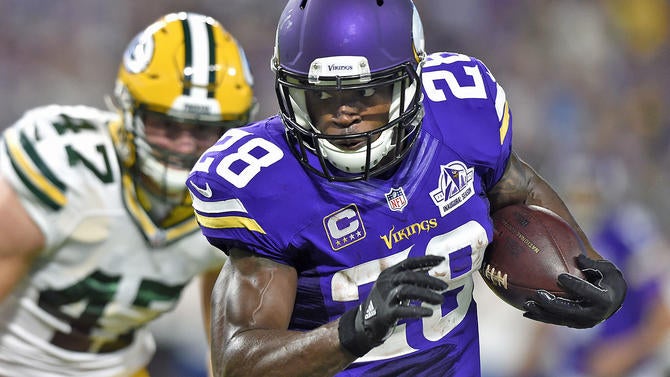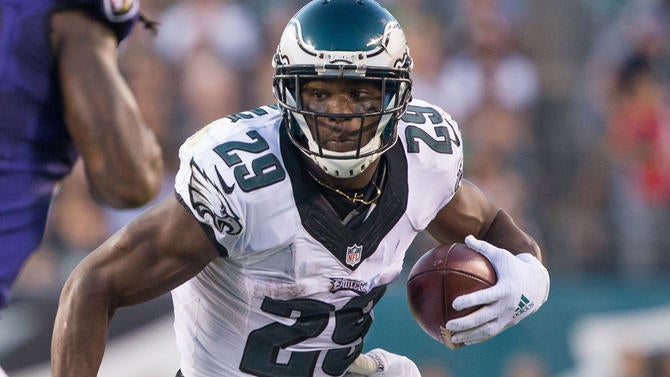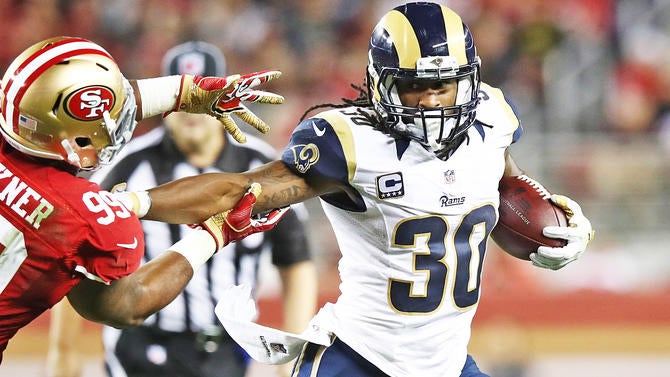Agent's Take: Sorry, Le'Veon Bell, the Adrian Peterson contract has gone extinct
As NFL salaries continue to rise, the high-priced RB is going the way of Blockbuster

VCRs, record stores, the Walkman, answering machines and video rental stores were elements of everyday life that are now obsolete. In the NFL world, high priced running backs are on the verge of suffering the same fate. They are endangered species despite the salary cap increasing by approximately eight percent annually in recent years.
The salaries at other positions, such as safety and wide receiver, have escalated with the increase in the cap. There were just three wide receivers with long-term contracts averaging at least $10 million per year in 2012. 14 wide receivers have multi-year deals at or above the $10 million per year mark this season. The escalation at the various positions should continue in the coming years with the expected growth in the cap. It is unlikely running back will benefit from the growth. Money at the top of the position has been on the decline since peaking in 2012.
That's bad news for the Steelers' Le'Veon Bell, the best dual-threat back in the NFL, who will be seeking a huge pay day when he becomes a free agent after the 2016. Here's an explanation why Bell -- and other young stud running backs -- are playing in the wrong era to get paid.
The pinnacle of running back salaries
Adrian Peterson and Chris Johnson took running back salaries to a new level in 2011 after several years of stagnation. Both signed deals that put them among the NFL's five highest paid non-quarterbacks. Johnson signed a four-year contract extension with the Titans averaging $13.5 million per year and containing $30 million in guarantees after a lengthy preseason holdout. Peterson received a six-year, $85.28 million extension from the Vikings which included $36 million in guarantees and an additional $4 million in base salary escalators.
Running back compensation reached a peak in 2012 when the number of players with veteran contracts averaging at least $7 million per year jumped from five in 2011 to 11 in 2012 thanks to new deals by Matt Forte, Arian Foster, Marshawn Lynch, LeSean McCoy, Ray Rice and Jonathan Stewart. Currently, there are only five at or above the $7 million threshold.
The chart below highlights the decline at the top of the running back market since its high-water mark by looking at the average of the top five running back contracts in a couple of basic metrics.
| Year | Average Guarantees | Average Yearly Salary | Average Length |
| 2012 | $25,803,000 | $10,834,100 | 5 Years |
| 2013 | $25,203,000 | $10,763,333 | 4.8 Years |
| 2014 | $19,153,000 | $10,103,636 | 4.4 Years |
| 2015 | $16,450,000 | $9,861,765 | 3.4 Years |
| 2016 | $17,500,000 | $8,620,000 | 4 Years |
Currently, Peterson is the NFL's only $10 million-per-year running back. Jamaal Charles, who signed a two-year, $18.1 million extension with the Kansas City Chiefs in 2014, is the league's second highest-paid running back by average salary at $9.05 million per year.
The situation is probably going to get worse with high end running back salaries next offseason. The two highest-paid running backs may not have a future with their respective teams.
2017 is the final year of Peterson's contract year. It is an option year that the Vikings must pick up by next March 9, the last day of the 2016 league year. He is scheduled to make $18 million, of which $6 million is a roster bonus payable on the third day of the 2017 league year (March 11), while carrying a cap charge of the same amount.

Peterson was off to an extremely slow start this year before having potentially season-ending surgery last week to repair a torn meniscus in his right knee. The 31 year old will need to renegotiate his contract to be more in line with the rest of the running back market in order to remain with the Vikings in 2017 and beyond.
Charles still hasn't returned from last October's ACL tear, the second one of his career. Surprisingly, the Chiefs won eleven straight games in 2015, including the playoffs, with Spencer Ware and Charcandrick West operating in his place. Ware and West signing identical three year, $4.2 million deals (worth a maximum of $8.2 million with salary escalators) suggests that the Chiefs have a succession plan in place at running back. Charles is likely playing his last season in Kansas City if he doesn't return to form with two reconstructed knees -- considering he is scheduled to make $7 million in 2017, which is his contract year, and turns 30 years old in late December.
2016 market developments
The unrestricted free agent deals of Doug Martin, Lamar Miller and Chris Ivory have given the false impression that the running back salaries are rising. These contracts helped bridged the gap between 2015's lower end of the top of the market, which was Stewart's five-year extension with the Panthers averaging $7.3 million per year, and the top of the middle class represented by the three-year free agent contract that Shane Vereen received from the Giants averaging $4,166,667 per year.
Martin got the best deal of the three free agents. He re-signed with the Buccaneers for $35.75 million (worth up to $42,937,500 with salary escalators and incentives) over five years where $15 million was fully guaranteed. The deal isn't nearly as impressive if put into a 2012 financial environment when the salary cap was $120.6 million instead of its current $155.27 million level. Martin's deal translates to a little over $5.5 million per year.
Miller received a five-year, $32.5 million contract with $14 million fully guaranteed from the Texans. Ivory signed a five-year, $32 million deal (worth a maximum of $35 million through salary escalators) with the Jaguars.
In actuality, the number of high-priced running backs has dwindled this year. Lynch retired after getting a two-year, $24 million extension from the Seahawks in 2015. Forte's four-year, $31.2 million deal with the Chicago Bears expired. The Texans released an injury-plagued Foster from the final year of his five-year, $43.5 million contract. Forte and Foster didn't come close to their previous contracts in new deals with the Jets and Dolphins.
DeMarco Murray became a cautionary tale for high-priced free agent running back signings. He gained 702 yards on the ground in 2015, the second-worst total in his five NFL seasons on a career low 3.6 yards per carry, after receiving a five-year, $40 million contract (with $21 million in guarantees and worth a maximum of $42 million through salary escalators) from the Philadelphia Eagles. Murray was dealt to the Titans early in the offseason in an exchange of 2016 fourth-round picks. He cut $5.45 million out of the remaining four years of his contract to make the trade work.

Le'Veon Bell's free agency
Le'Veon Bell could be the litmus test for high-end running back compensation. He is the NFL's best dual-threat running back when healthy. In 2014, Bell became the only running back, besides Marshall Faulk and Steven Jackson, to record at least 1,300 rushing yards (1,361 yards) and 800 receiving yards (854 yards) in the same season.
Bell's 2015 season was cut short by a torn MCL and PCL in his right knee which occurred during Week 8's game against the Bengals. Completely healthy now, Bell will be making his season debut this week against the Chiefs because of a three-game suspension for violating the NFL's substance abuse policy, which is his second drug suspension in as many years.
The Steelers are content to let Bell play out his rookie contract because of the injury and off-the-field issues. Durability and dependability are concerns Bell needs to erase or alleviate before he tries to secure a lucrative contract next offseason.
It remains to be seen whether Bell will exceed the maximum value of the five-year extension Jackson signed with the St. Louis Rams in 2008, which was approximately $49 million ($9.8 million per year), because of the decline at the top of the running market. The Steelers have the option of placing a franchise or transition tag on the 24 year old in 2017. Assuming a similar eight percent increase in the cap as in recent years, the 2017 running back franchise and transition numbers should be in the neighborhood of $12.4 million and $10.15 million.

A transition tag would come with some risk because the Steelers would only get a right to match an offer sheet from another team instead of two first-round picks as compensation under the franchise tag when matching rights are declined. The Steelers have been one of the biggest proponents of the seldom-used transition tag, applying it to offensive tackle Max Starks in 2008 and linebacker Jason Worilds in 2014.
Churning and second contracts
There's a school of thought in the NFL that a team should avoid giving a running back an extremely lucrative second contract unless he's a special talent because productive ball carriers can be found all over the NFL draft and from the undrafted ranks. For example, Ivory, an undrafted free agent in 2010, and Latavius Murray, a sixth-round pick of the Raiders in 2013, were the AFC's top two rushers last season. Justin Forsett, who was a seventh-round pick in 2008, led the NFL in 2014 with 5.4 yards per carry and finished fifth in rushing with 1,266 yards. Avoiding the pricey second contract eliminates the risk of overpaying a running back in his late 20s when most are declining and there are diminishing returns.
The 2017 draft could really put this idea to the test because it has the potential to be the deepest class of running backs in recent years if the top underclassmen come out. Next year's draft could be the first since 2011 to have three running backs taken in the first round. Leonard Fournette (LSU), 2015 Heisman Trophy runner up Christian McCaffrey (Stanford), Dalvin Cook (Florida State), Nick Chubb (Georgia) and Royce Freeman (Oregon) have first-round talent. It's unlikely all will go that high assuming they are available to be drafted, which means a great value could be had as late as the third round.
Teams with impending free-agent running backs, including the Steelers with Bell, could have more leverage in negotiations than in other years because of the potential to move on with younger cheaper alternatives. Two other situations worth watching are Eddie Lacy's with the Packers and Murray's in Oakland.
Lacy had a 2015 to forget. He seems intent on putting his disappointing season behind him. He was overweight, eventually lost playing time and had a career-worst 758 rushing yards. In much better shape, Lacy is averaging five yards per carry and on pace to crack the 1,000-yard rushing mark for the third time in his four NFL seasons.
Murray became Oakland's first 1,000-yard rusher since Darren McFadden in 2010 but was less effective as the 2015 season progressed. 436 of his 1,066 rushing yards came in the first eight games of the season. His yards per carry went from 4.8 in the first half of the season to 3.3 over the last eight games.
Murray's workload has decreased so far this season because of rookies DeAndre Washington and Jalen Richard. This should prevent Murray from wearing down late in season like he did last year. The Raiders making the transition from a low-paid quarterback to a high-priced one with the extension Derek Carr is expected to sign next offseason and All-Pro defensive end/linebacker Khalil Mack potentially becoming the NFL's highest paid non-quarterback within the next couple of years could impact how much the team is willing to spend to keep Murray.
The future for star running backs
Once Adrian Peterson's mega-contract is out of the equation, it will probably be years before another running back signs a deal approaching his. If Bell doesn't hit the $10 million per year mark, it could take some time before another running back does.
2015 10th-overall pick Todd Gurley would be the most logical candidate to reach the $10 million per year threshold. He was named the NFL's Offensive Rookie of the Year last season after rushing for 1,106 yards in 13 games. As a top-10 pick, the Rams have an option for a fifth year with Gurley that must be exercised by May 2 after the third year of his rookie contract, which is in 2018.

Gurley has the worst value for a fifth-year option relative to the salary structure at the various positions. His option year salary, which will be the same as the 2018 running back transition tag, should be over $10.5 million. He becomes eligible to sign a contract extension after the 2017 regular season ends. Fortunately for Gurley, the Rams have a track record for signing productive first-round picks to extensions either before the start of or during the early part of their fourth season.
David Johnson, a 2015 third-round pick, could become a legitimate lucrative contract candidate. He has become an every-down running back for the Arizona Cardinals this season. Johnson has drawn comparisons to Marshall Faulk because of his dual-threat capabilities. Living up to those lofty comparisons will ensure that Johnson is paid at the top of the market on his next contract.
















